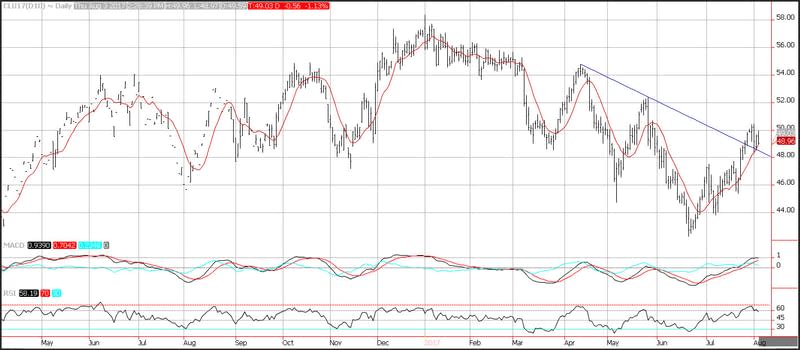Crude Oil Price Analysis for August 4, 2017
Crude oil prices ended the day in the red, after attempting to move higher early in the trading session. Demand continues to improve, and inventories are declining. The Saudi’s latest attempt to push prices higher has them focused on export, which actually increased according to OPEC in the latest week. Venezuela could be an issue for the United States who exports 741K barrels a day, and a decline in import could generate additional volatility.
Technicals
Prices whipsawed, closing down 1.1%, initially moving higher but closing near support near the 10-day moving average at 48.96. Resistance on crude oil is seen near the weekly highs at 50.41. Prices remain in an uptrend after breaking out above a downward sloping trend line which is seen as support below the 10-day moving average at 48.65. Momentum has stalled as the MACD (moving average convergence divergence) histogram has a negative trajectory which the index continues to print in the black, which reflects decelerating positive momentum.

Venezuela is an important oil exporter and the country possesses the largest oil reserves in the world, greater than even Saudi Arabia. Their major export is heavy oil, and is used widely by U.S. refiners who have coking processor that can turn heavy oil into lighter oil. The looming U.S. sanctions are about to make it even more expensive. Caracas has for some time been importing lighter American crude to mix with its own volume, making its export blend lighter and allowing its largest refinery on the island of Curacao to produce oil products essential for both domestic consumption and export.
The latest figures indicate that 105,000 barrels of U.S. oil are exported daily to Venezuela, while the Energy Information Administration puts daily American imports from Venezuela averaging 741,000 barrels for all of 2016. The sole factor in determining import levels is cost. Despite the largess in domestic reserves, U.S. refineries will import to benefit their refinery margin.
The reduction in Venezuelan oil could further reduce inventories. The EIA reported that U.S. commercial crude oil inventories decreased by 1.5 million barrels from the previous week. Gasoline inventories decreased by 2.5 million barrels last week, while distillate fuel inventories decreased by 0.2 million barrels last week. Despite a decline in each of the 3-major categories, total commercial petroleum inventories increased by 1.1 million barrels last week.
Demand in the U.S. is Climbing
Demand for products is moving higher. The DOE reported that total products demand over the last month averaged about 20.8 million barrels per day, up by 1.4% from the same period last year. Over the month, gasoline demand averaged about 9.8 million barrels per day, up by 0.1% from the same period last year. Distillate fuel demand continues to impress, as it averaged about 4.2 million barrels per day over the last month, up by 14.5% from the same period last year.
Growth in China’s services sector slows in July
The Caixin/Markit services purchasing managers’ index (PMI) dropped to 51.5 in July from 51.6 in June. New business continued to expand at a decent clip but at a slightly slower pace. The rate of growth in new work eased to a 16-month low. Employment in the services industry improved slightly as companies continued to add workers. The services sector, accounting for just over half of China’s economy in the first half of the year, grew 7.7% easily outpacing overall GDP growth of 6.9%.
Japan service sector growth softens in July
The Markit/Nikkei Japan Services Purchasing Managers Index declined to 52.0 from 53.3 in June. Growth in new business eased but dipping to 52.7 from 53.2. The services sector PMI comes shortly after the final manufacturing PMI which showed Japan’s factory activity grew at the slowest pace in eight months. Taken together, the composite PMI, which includes both manufacturing and services, fell to 51.8 in July from 52.9 in June.
Jobless Claims Declined in the Latest Week
A weak dollar is buoying oil prices. U.S. initial jobless claims fell 5k to 240k in the week ended July 29 after bouncing 11k to 245k in the June 22 week which was revised from 244k. That brought the 4-week moving average to 241.75k from 244.25, which was revised from 244k. Claims have been below 300k for 126 consecutive weeks, the longest stretch going back to 1970. Continuing claims rose 3k to 1,968k in the June 22 week, following the 12k drop to 1,965k (revised from 1,964k). The BLS said there were no special factors impacting the numbers.
This article was originally posted on FX Empire

